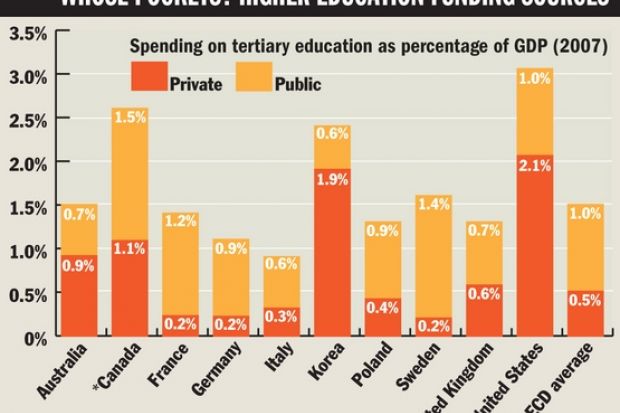Traditional "big hitters" in higher education such as the UK and the US are losing their allure for international students thanks to the dramatic pace of change and intensifying competition in the global academy, a key study suggests.
An annual report by the Organisation for Economic Cooperation and Development shows that emerging economies are catching up with - and in some cases overtaking - the big industrial nations on a variety of vital indicators.
Over the past decade, graduation rates have leaped up in countries such as Finland, Slovakia and the Czech Republic while rising only modestly elsewhere, Education at a Glance, published this week, shows.
Some expanding higher education systems are in turn starting to attract a larger share of the lucrative pool of international students, which grew 10.7 per cent from 2007 to a total of 3.3 million students in 2008.
Although five countries - Australia, France, Germany, the UK and the US - still hosted half of the world's overseas students in 2008, the US has seen its share of the market drop from 26 per cent to 19 per cent since 2000. Meanwhile, Russia and South Korea - along with Australia and New Zealand - have gained ground.
The UK's market share fell by 2 percentage points in the same period.
Andreas Schleicher, head of the Indicators and Analysis Division at the OECD's Directorate for Education, said: "Even if you improve, but your rate of progress is slower, then you can fall back, and the pace is so quick that these changes are dramatic."
Whether a system was predominantly publicly or privately funded was often irrelevant, he said, but he warned that countries in Europe such as France and Germany - which were failing to find additional income for higher education from private sources - risked lagging behind.
As a share of national income, overall spending on higher education from both public and private sources remained relatively static across the 32 OECD nations from 2006 to 2007, according to the report.
However, those worried about impending funding cuts in the UK will point to the country's unchanged 1.3 per cent investment.
The UK has fallen further behind the OECD average, which now stands at 1.5 per cent.
In terms of public spending on education, Britain is among the lowest in the group at 0.7 per cent of gross domestic product, while the latest figures for Canada - from 2006 - show government spending constituted 1.5 per cent against a total of 2.6 per cent.
Largely as a result of the introduction of tuition fees, spending per student by institutions in the UK has shot up over the past 10 years to $15,463 (£10,057) in 2007, but this figure includes money spent on research.
Without research money, the British sum falls to £5,874, far behind the figure spent in the US (£15,109 without research) and Canada (£9,581).
The latest OECD figures come just days before the publication of the new Times Higher Education World University Rankings, which may be scrutinised closely for evidence that the UK's static spending has affected its global position, even before the advent of cuts.
Steve Smith, president of Universities UK, was expected to tell UUK's annual conference on 9 September that foreign competitors were watching the British situation closely for signs that its former comparative advantage could be weakened further by fresh cuts.
Others said the UK now had an unenviable choice between educating more students at a cut price or retrenching on numbers to preserve quality.
"It is unfortunate that this choice has to be made," said Bahram Bekhradnia, director of the Higher Education Policy Institute.
Ideas to boost the sector's income will be offered by the independent review of funding and finance led by Lord Browne of Madingley.
It is due to report in the second week of October, a week before the government's Comprehensive Spending Review is published.
THE OECD'S EDUCATION AT A GLANCE REPORT: KEY POINTS
• Across the OECD, the number of 20- to 29-year-olds enrolled in full- or part-time education increased by 7.7 per cent from 1995 to 2008.
• Graduation rates for young women are 46 per cent on average compared with 30 per cent for men.
• 17 per cent of all overseas students come from China.
• In Japan, South Korea, the UK and the US, more than 60 per cent of the academy's costs are covered by private sources. The figure is under 10 per cent in Belgium, Denmark, Finland, Iceland and Norway.
• Unemployment rates for graduates have stayed below 4 per cent. However, earning premiums for graduates have fallen slightly in New Zealand, Sweden and the UK.
• The return to the taxpayer from government investment in higher education averages $86,000 (£56,000) per student.
• The student dropout rate averages 31 per cent across the OECD and is highest in the US, New Zealand and Sweden.
